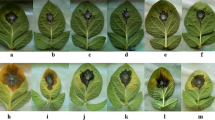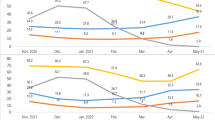Abstract
Foliar and tuber blight caused by Phytophthora infestans accounts for significant losses in potatoes in field and storage. Nevertheless, limited research has been published on the effects of cultural practices on late blight control. Field experiments were conducted in two years on Howard gravely loam soil in New York State to evaluate the effectiveness of mulching using oat straw and hilling in preventing tuber blight infection for cvs Allegany and Katahdin. Potato hilling and mulching had little effect on foliar blight development. The cultivar affected the disease development in the foliage, with cv. Allegany showing lower foliar late blight than cv. Katahdin. Tuber blight incidence averaged 25% for cv. Allegany and 3% for cv. Katahdin in hilled plots, while in the mulched plots the incidence of tuber blight averaged 33% for cv. Allegany and 10% for cv. Katahdin. The straw hay mulch was ineffective in tuber blight control. Tubers set at a soil depth of more than 7 cm had lower tuber blight incidence than shallow tubers set at a depth of less than 7 cm. In both years, hilling provided partial protection of tubers but its effectiveness was limited in the presence of favourable conditions for late blight development. Even though large hills had proportionally a lower tuber blight incidence than medium-sized hills, the difference between the different hill sizes was not significant. These studies suggest that the use of cultivars with foliage resistance to late blight in combination with cultural practices may partially reduce the incidence of tuber blight.



Similar content being viewed by others
References
Andrivon D (1995) Biology, ecology, and epidemiology of the potato late blight pathogen Phytophthora infestans in soil. Phytopathology 85:1053–1056
Bain RA, Moller K (1999) Factors influencing tuber infection by Phytophthora infestans. In: Schepers H, Bouma E (eds) Proceedings of the workshop on the European network for development of an integrated control strategy of potato late blight, Uppsala, Sweden, 9–13 September 1998. PAV – special report no. 5. Applied research for arable farming and field production of vegetables, Lelystad, pp 210–227
Cooke LR, Little G (2002) The effect of foliar application of phosphanate formulations on the susceptibility of potato tubers to late blight. Pest Manag Sci 58:17–25
Dubey T, Stevenson WR (1996) Factors affecting the movement and viability of sporangia of Phytophthora infestans in soil (abstr.). Phytopathology 89:S61–S62
Erwin DC, Ribeiro OK (1996) Phytophthora diseases worldwide. American Phytopathological Society Press, St Paul
Evenhuis A, Kessel GJT, van Bekkum PJ (2006) Epidemiology of P. infestans in relation to tuber blight-survival of P. infestans sporangia in field soils. In: Westerdijk CE, Schepers HTAM (eds) Proceedings of the ninth workshop of an European network for development of an integrated control strategy of potato late blight, Tallinn, Estonia, 19th–23rd October 2005. PPO – special report no. 11. Applied Plant Research, Lelystad, pp 223–228
Flier WG, Turkensteen LJ, Mulder A (1998) Variation in tuber pathogenicity of Phytophthora infestans in the Netherlands. Potato Res 41:345–354
Fry WE, Goodwin SB (1997) Resurgence of the Irish potato famine fungus. Bioscience 47:363–371
Glass JR, Johnson KB, Powelson ML (2001) Assessment of barriers to prevent the development of potato tuber blight caused by Phytophthora infestans. Plant Dis 85:521–528
Hirst JM, Stedman OJ (1962) The infection of potato late foliage and tubers by Phytophthora infestans. In: Rothamst Exp St Rep 1961. Rothamsted Experiment Station, Harpenden, pp 113–114
Hirst JM, Stedman OJ, Lacey J, Hide GA (1965) The epidemiology of Phytophthora infestans. IV. Spraying trials, 1959 to 1963, and the infection of tubers. Ann Appl Biol 55:373–395
Kirk WW, Felcher KJ, Douches DS, Niemira BA, Hammerschmidt R (2001) Susceptibility of potato (Solanum tuberosum L.) foliage and tubers to the US-8 genotype of Phytophthora infestans. Am J Potato Res 78:319–322
Lacey J (1966) The distribution of healthy and blighted tubers in potato ridges. Eur Potato J 9:86–96
Lacey J (1967a) The role of water in the spread of Phytophthora infestans in the potato crop. Ann Appl Biol 59:245–255
Lacey J (1967b) Susceptibility of potato tubers to infection by Phytophthora infestans. Ann Appl Biol 59:257–264
Lambert DH, Currier AI (1997) Differences in tuber rot development for North American clones of Phytophthora infestans. Am Potato J 74:39–41
Lambert DH, Currier AI, Olanya MO (1998) Transmission of Phytophthora infestans in cut potato seed. Am J Potato Res 74:39–43
Lapwood DH (1977) Factors affecting the field infection of potato tubers of different cultivars by blight (Phytophthora infestans). Ann Appl Biol 85:23–42
Nyankanga RO, Wien HC, Olanya OM, Ojiambo PS (2007) Relationship between late blight (Phytophthora infestans) of potato on tuber and foliage, as affected by the disease severity on foliage, cultivar resistance, and atmospheric and soil variables. Can J Plant Pathol 29:372–387
Olanya OM, Lambert DH, Johnson SB, Dwyer JD (2002) Assessment of the impact of mid-season late blight infection on disease development and yield of potato variety Russet Norkotah in Maine. Int J Pest Manag 48:139–146
Olanya OM, Ojiambo PS, Nyankanga RO (2006) Dynamics of development of late blight (Phytophthora infestans) in potato, and comparative resistance of cultivars in the highland tropics. Can J Plant Pathol 28:84–94
Pfender WF, Hine RB, Stangehellini ME (1977) Production of sporangia and release of zoopores by Phytophthora megasperma in soil. Phytopathology 67:657–663
Platt HW, Tai G (1998) Relationship between resistance to late blight in potato foliage and tubers of cultivars and breeding selections with different resistance levels. Am J Potato Res 75:173–175
Rowe RC, Secor GA (1993) Managing potato health from emergence to harvest. In: Rowe RC (ed) Potato health management. American Phytopathological Society, St Paul, pp 35–57
Shaner G, Finney RE (1977) Effect of nitrogen fertilization on the expression of slow-mildewing resistance in knox wheat. Phytopathology 68:657–663
Stevenson WR (1993) Management of early blight and late blight. In: Rowe RC (ed) Potato health management. American Phytopathological Society, St Paul, pp 141–147
Zan K (1962) Activity of Phytophthora infestans in soil in relation to tuber infection. Trans Br Mycol Soc 45:205–221
Acknowledgements
The authors are grateful to the Rockefeller Foundation for partially funding this research as part of the first author’s Ph.D. dissertation at Cornell University. We thank Professor William Fry’s laboratory for culture of US-8 isolate and the USDA-ARS, New England Plant, Soil and Water Laboratory for technical and logistical support.
Author information
Authors and Affiliations
Corresponding author
Additional information
Mention of trade names or commercial products in this publication is solely for the purpose of providing specific information and does not imply recommendation for endorsement by Cornell University or the US Department of Agriculture.
Rights and permissions
About this article
Cite this article
Nyankanga, R.O., Wien, H.C. & Olanya, O.M. Effects of Mulch and Potato Hilling on Development of Foliar Blight (Phytophthora infestans) and the Control of Tuber Blight Infection. Potato Res. 51, 101–111 (2008). https://doi.org/10.1007/s11540-008-9093-2
Received:
Accepted:
Published:
Issue Date:
DOI: https://doi.org/10.1007/s11540-008-9093-2




